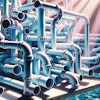
“You must be shapeless, formless, like water. When you pour water in a cup, it becomes the cup. When you pour water in a bottle, it becomes the bottle. When you pour water in a teapot, it becomes the teapot. Water can drip and it can crash. Become like water, my friend.” — Bruce Lee
I’ve always believed that in nature and life itself, “change is the only constant.”
The meaning of that age-old adage once again materialized as I was preparing this month’s edition of AQUA Architecture. I was working with John Talucci, who authors one of this month’s features, “An Innovative Technique to Make Commercial Pool Builds Easier,” when he shared with me the above quote from martial arts legend and film star, Bruce Lee.
“Johnny T.,” as he’s known to his friends and associates, quoted Lee as he related some profound thoughts about working with water’s infinite character and the way the very nature of water requires almost constant adaptation.
I had only recently come to know John, yet it became immediately apparent that he is one of those thoughtful professionals in our industry who feels that through his work constructing vessels for recreation, exercise and competition, he is harnessing the unique power of water to positively impact the human experience.
That’s heady stuff, but it’s also ultimately practical. After all, immersion in water, or simply being in the presence of water, is at its core what our industry is all about. Whether we realize it or not, no one involved in aquatics can ever escape that fundamental reality.
When we talk about the arts and crafts of “aquatic architecture,” however, the discussions on the surface take on a very different kind of pragmatic tenor and necessarily involve topics that are far from poetic. Fact is, creating reliable systems that deliver the aquatic experience is always steeped in gritty work, the kind that raises calluses on hands, drives dirt under the fingernails and causes aches and pains from head to toe.
In his article, Talucci talks about the pride and inspiration he draws from the works of Italian masons past and present. No doubt the soaring beauty of Rome’s Pantheon or Michelangelo’s David required dusty, sweaty toil that only the sturdiest of minds and bodies could endure.
Similarly in today’s world of aquatic spaces, the formless grace of water can only be harnessed by people who dig holes, lay steel, run plumbing, pour concrete, pull wire and apply finish materials — hardly the fanciful realm of poets and philosophers. Yet, when executed at the highest level, the results are settings that nourish the mind, body, heart and soul.
With all that in mind, I believe there’s another level of meaning we can draw from Lee’s quote and the attendant notion that adaptation is essential to survival in today’s down and dirty world of contracting. That the most successful practitioners of the aquatic trades are those whose work traverses shifting tides of economic and demographic change year after year.
To be successful in this type of field where every project is different, every client is different, every season is different; the ability “to become the teapot” is an essential characteristic for success. And nothing about that is easy. Adapting to change requires courage, risk, patience, ambition, flexibility and knowledge across a range of disciplines.
For some of us older folk, that change has meant adapting to the brave new world of digital communication. All of which is why turning to the Internet and social media encompasses a spectrum of discussions found in this magazine and other sources of information.
More specific to pool and spa design/construction, change often means realizing that bodies of water exist in context of the overall exterior setting, a mode of thinking and operation that fuses the work of aquatic professionals with that of landscape architects, architects and host of other tangential disciplines.
In the same sense, understanding evolving consumer tastes and trends further complicates the picture, especially now as the Baby Boomer generation enters retirement and seeks at-home resorts as well as venues for family activity and even life-sustaining exercise and hydrotherapy.
In that respect, everyone in this business, and most other types of businesses as well, will always be works in progress. That’s why standing pat with how you think, what you know and what you do is a prescription for mediocrity if not out-and-out failure.
With change there is always opportunity, even if the forces driving the change at hand initially seem negative. Most of those who author stories in AQUA Architecture have weathered their own storms and will in their own ways attest to the necessity of adaptation.
I doubt most would contour their accounts with the Zen-like flair of Bruce Lee, or even Johnny T., but at heart, those who elevate aquatic architecture to a sustainable art form, have in common the ability to “become like water.”
Comments or thoughts on this article? Please e-mail [email protected].








































